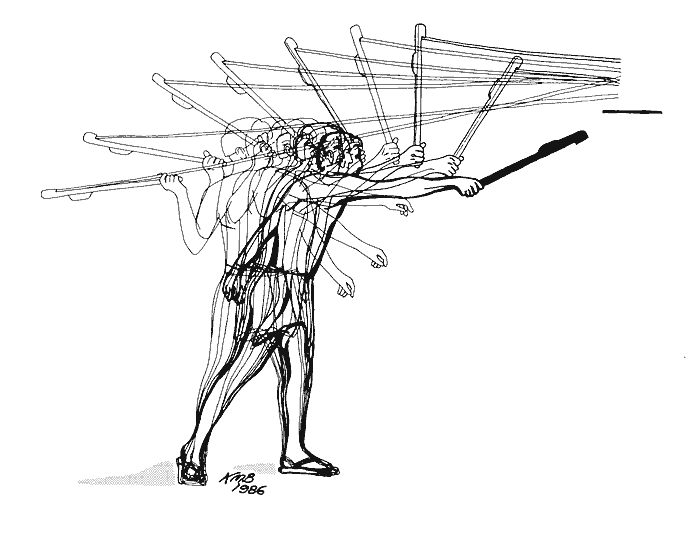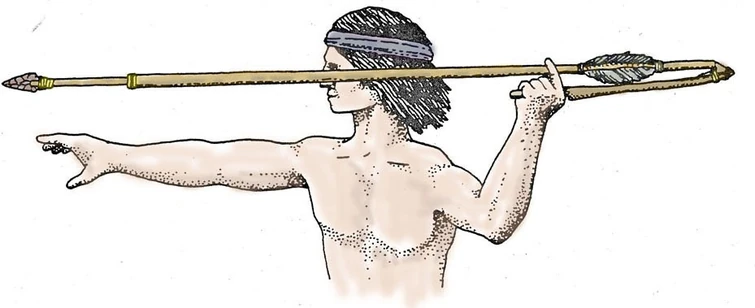Atlatl – The Spear Thrower
Atlatl – The Spear Thrower
Now, we know that a spear thrower is not a bow and arrow. A spear thrower, also commonly called an atlatl is a device used to enhance the speed of a spear, javelin, or dart. The curious word, atlatl comes from the Classical Nahuatl, also known simply as Aztec or Nahuatl. The term was first noted by the American anthropologist Zelia Nuttall [1857–1933]
But like the article we did on the sling, we think the spear thrower deserves some exploration and respect. The atlatl, like the bow and arrow, and the sling are ancient and widely used. This device gives us a glimpse into our remote past. The study of these early tools is a study of the early history of humanity, our struggles against nature, and our ingenuity. This article explores the spear thrower or atlatl, its history, construction, use, and physics.
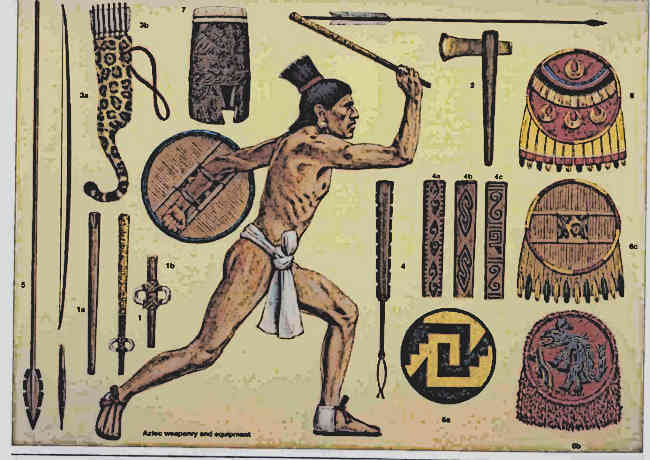
What is an Atlatl Spearthrower?
The word atlatl is an odd one for English speakers. The term “atlatl” finds its roots in the Nahuatl language, spoken by indigenous peoples of Mesoamerica. In Nahuatl, “atlatl” translates to “water thrower” or “spear thrower,” indicating its primary function as a tool for launching projectiles. The Nahuatl term eventually found its way into the English language as “atlatl,” becoming the widely accepted name for this ancient device.
Atlatl Pronunciation
Not sure how to pronounce the word? You are not alone, it is a tricky one. The below video gives some quick examples of how it is commonly pronounced in American English.
Leverage
The atlatl itself is a relatively simple device. It typically consists of a shaft with a small cup or prong which holds the butt of the spear or dart. Once the projectile is affixed to the atlatl, the user grasps the device at the other end.
The thumb and index finger may extend to grip the projectile. Then in an overhand javelin-throwing fashion, the user swings the device forward, propelling the projectile. A typical atlatl is about the length of the average person’s forearm and basically acts as an extra extension of a thrower’s arm. This greatly increases the leverage of the throw, allowing the projectile to be propelled much faster, and with greater kinetic energy.

History of the Atlatl Spearthrower
Spears are nothing new, and neither is throwing. Put the two together and you can have some good hunting. The earliest evidence of spears goes back to the dawn of history when early humanoids were just beginning to use stone tools. This era, known as the Paleolithic spanned from 3.3 million years ago, to the end of the Pleistocene, circa 11,650 cal BP. Yes, a long time ago.
An interesting thing to consider is that humans have spent most of their time as hunter-gatherers. This is especially true if we consider our older humanoid ancestors, like Neanderthals. The earliest evidence of small-scale farming of edible grasses is from around 21,000 BC [1]. Considering that anatomically similar humans have existed for approximately 300,000 years, this would mean we were hunting for hundreds of thousands of years before practicing settled farming. What were we hunting with? Mostly with spears.
Earliest Evidence of Spears
The oldest currently accepted spearpoint was discovered in 1911 in Clacton-on-Sea, a seaside town in the southeast of England [2]. Samuel Hazzledine Warren, the discoverer, and an amateur archaeologist and historian found it while looking for stone tools and other potential artifacts in a known Paleolithic sediment layer. At first, it was assumed to be an antler or horn, but later examination revealed it to be made of yew.
The spear tip is 387 mm long with a 39 mm diameter. It was dated over 400,000 years old! It is currently housed at the Natural History Museum, London. Attempts at reproducing the artifact have suggested it was shaved to a point using rudimentary curved flint tools. This ability at manufacturing an item in a multistage process also suggests human cognitive abilities were well on their way to what we have in modern humans. Because of the age of the artifact, there was some doubt that it was a spear. Some academics cast doubt on the idea that this relatively advanced manufacturing of tools with other tools was within the cognitive ability of early hominids. It was after the discovery of the Schöningen Spears in 1995 in Germany that the idea humanoids this old were making things with multistage planning and execution of builds began to seem more likely.

The Schöningen Spears
The Schöningen Spears, also known as the Schöningen lances or javelins, is a collection of ancient wooden hunting spears that provide valuable insights into human evolution and prehistoric hunting practices. These remarkable artifacts were discovered at the open-cast lignite mine in Schöningen, Germany.
The spears were unearthed during the 1990s in a series of excavations led by Dr. Hartmut Thieme, an archaeologist from the Lower Saxony State Office for Cultural Heritage. The initial discovery was made in 1994 when a single wooden spear was found. This finding sparked further exploration, leading to the unearthing of a total of ten spears to date.

The excavation site in Schöningen is situated in the vicinity of an ancient lake bed, which was a highly favorable environment for prehistoric human settlements. The spears were found embedded in layers of waterlogged sediment, which preserved them exceptionally well. This unique preservation allowed scientists to study the spears in great detail and gain crucial insights into human history.
The significance of the Schöningen Spears lies in several aspects. Firstly, their age is remarkable, as they date back to approximately 300,000 years ago, during the Middle Pleistocene era. This makes them the oldest known complete hunting weapons ever discovered. The spears are associated with Homo heidelbergensis, an extinct hominin species that is considered an ancestor of both Neanderthals and modern humans.
Skilled Hunters
The discovery of these well-preserved wooden spears challenged the prevailing belief that early hominins were merely scavengers and not skilled hunters. The Schöningen Spears provide concrete evidence that our ancient ancestors were capable of hunting large game, such as horses. The spears exhibit features specifically designed for hunting, including sharpened tips and fire-hardened points, which increased their effectiveness as weapons.
The Schöningen Spears also shed light on the technological capabilities of Homo heidelbergensis. The spears were carefully crafted with remarkable precision, demonstrating sophisticated woodworking skills. This suggests that early humans had a high level of cognitive and manual dexterity, enabling them to create functional tools for specific purposes.
Currently, the Schöningen Spears are kept and displayed at the paläon Research and Experience Center in Schöningen. This state-of-the-art facility provides a comprehensive overview of the archaeological findings from the area, including the spears themselves. Visitors can witness these ancient artifacts firsthand, learn about their significance, and explore the broader context of human evolution and history.
Thrusting or Throwing?
How were these spears actually used? Were they thrusting or throwing spears? Perhaps they were multi-use weapons, primarily throwing weapons but easily doubling as close-range self-defense utensils.
The spears vary in length from 1.84 to 2.53 m (6.04 to 8.30 ft), with diameters ranging from 29 to 47 mm (1.14 to 1.85 in) [3]. Most are made from spruce and one is made from pine. The majority of the ten spears were tapered at both ends with the balance point about one-third (1/3) of the way up from the tip. This design is very similar to modern competition javelins.
While it is true that the tapered shape and balance point of the Schöningen Spears resembles those of throwing spears, it is important to consider other factors as well. The archaeological context and wear patterns observed on the spears provide additional insights into their potential use.

The spears were discovered embedded in waterlogged sediment and exhibited wear patterns consistent with thrusting actions, such as impact fractures near the tips. These factors suggest a close-range hunting context, where the spears were likely used for stabbing or thrusting rather than long-range throwing.
Therefore, the interpretation of the Schöningen Spears as primarily thrusting spears is supported by the archaeological evidence and the wear patterns observed. While the tapered shape and balance point resemble throwing spears, the overall context points towards a different mode of use.
It is worth noting that the exact function and versatility of these spears in the hunting practices of Homo heidelbergensis remain topics of ongoing study and interpretation.
New Research
Some new research conducted by archaeologist Annemieke Milks, of the Lower Saxony State Office for Heritage in Germany sheds new light on the potential for spears being used as projectiles in our very distant past.
Humans, compared to other animals, are not really that good at much. We’re not that fast, we’re not very good climbers, jumpers, or swimmers. There are many animals today and in the past that would put us to shame. But we do have something that other animals do not. We are indeed the best at something. If you guessed throwing you would be correct. Adult male chimpanzees in their prime can throw a softball at 20 mph, yet human boys age 6 to 8 can throw the same ball at over 40 mph. We are the animal kingdom’s best throwers by far. Baseball professionals at the top of the game can exceed 100 mph!
The experiment involved using replica Schöningen Spears and handing them off to trained and experienced javelin athletes. Feedback from the participants assured the researchers that the replicas have the feel of modern equivalents. Accurate throws averaged distances of 85 feet.
Read more on this particular study by following this link.
The Atlatl
The atlatl spearthrower is believed to have been used by early Homo sapiens since the Upper Paleolithic (around 30,000 years ago) [4]. Several finds come to us from the Magdalenian cultures of Europe in the Upper Paleolithic about 21,000 to 17,000 years ago. Many examples are elaborately carved from wood, horn, or antler and have animal motifs. So far, the oldest example is 17,500 years old. It was discovered at Combe Saunière (Dordogne), France. [5]
The Ancient Atlatl
The use of reindeer antler in creating the atlatl showcases the adaptability and resourcefulness of early humans. They utilized the available natural materials to fashion effective hunting tools. Reindeer antler, known for its strength and durability, proved to be a suitable choice for crafting this tool. The skill required to shape the antler into an atlatl demonstrates the knowledge and expertise possessed by these early hunters.
The atlatl itself is a spear-throwing device consisting of a handle or grip, typically made of wood or bone, and a projection at the front to support the spear or dart. By leveraging the atlatl, hunters could enhance the reach and power of their throws, increasing their accuracy and success rates in hunting endeavors.

The discovery of the Combe Saunière atlatl offers valuable insights into the hunting strategies and way of life during the Solutrean period, which spanned from approximately 22,000 to 17,000 years ago. The Solutrean culture was renowned for its advanced stone tool technology and adeptness in hunting large game such as reindeer.
The presence of this atlatl suggests that the Solutrean people were highly skilled hunters, employing efficient and precise techniques. Utilizing the atlatl, they could engage in long-range hunting, maximizing their chances of success while minimizing the risks associated with close-quarter combat against formidable and potentially dangerous animals
Mungo Man
Mungo Man, an important archaeological discovery, was found in Lake Mungo, a dry lake bed located in southwestern New South Wales, Australia. The remains were unearthed in 1974 by archaeologist Jim Bowler during excavations conducted at the site.
The discovery of Mungo Man was significant not only for its age but also for its cultural and historical implications. The remains were estimated to be around 42,000 years old, making them one of the oldest human remains in Australia.
Mungo Man was uncovered in what is known as the Willandra Lakes region, an area that was once a series of large lakes and wetlands. The remains were found within the Lake Mungo lunette, a crescent-shaped dune formation on the lake’s eastern shore.

The excavation of Mungo Man provided important insights into the ancient Aboriginal people who inhabited the region. The discovery shed light on their burial practices and cultural traditions, as well as their ability to adapt to and thrive in a diverse and changing environment.
The remains of Mungo Man consisted of a partial skeleton, including fragments of the skull, teeth, and limb bones. These remains were carefully recovered and subsequently subjected to extensive scientific analysis, including radiocarbon dating.
Altalt Elbow
The arthritic condition of Mungo Man was determined through a detailed analysis of his skeletal remains. Various indicators and characteristics pointed towards the presence of arthritis in his right elbow.
Firstly, the examination of the bones revealed specific degenerative changes in the joint of the right elbow. These changes included the formation of bone spurs, joint erosion, and remodeling of the bone surfaces. Such alterations are commonly associated with arthritis, a condition characterized by inflammation and deterioration of the joints.
Additionally, the comparison of Mungo Man’s right elbow with the corresponding joint in his left arm provided further evidence. The asymmetry between the two elbows, with more pronounced degenerative changes observed in the right elbow, strongly suggested a localized pathology rather than a generalized skeletal condition.
Moreover, the specific type of arthritis displayed by Mungo Man, known as “Atlatl elbow,” was identified based on the distinctive characteristics of the joint damage. The repetitive torsional stress and strain placed on the elbow during atlatl usage, a tool utilized for spear-throwing, are known to cause this specific form of arthritis. The presence of such damage in Mungo Man’s right elbow indicates a long history of forceful and repetitive motion associated with using an atlatl. [6]
Indeed the Australian aborigines have their own unique spear-throwing device known as a woomera, which we will explore further in a following section.
Big Game Hunting
During the Ice Age, humans actively used the atlatl as a crucial tool to hunt megafauna. They skillfully targeted and captured these large-bodied animals, drawing knowledge from diverse sources: archaeological evidence, cave paintings, and analysis of ancient tools.
Spanning approximately 2.6 million to 11,700 years ago, the Ice Age witnessed numerous glaciations and notable climate fluctuations. Megafauna, known for their substantial size, inhabited various regions.
Archaeological excavations uncovered abundant artifacts associated with atlatl usage: spear points, darts, and atlatl fragments. These findings directly confirm the atlatl’s role in hunting megafauna. Additionally, the close proximity of these artifacts to megafaunal remains suggests a clear connection to hunting practices.

Furthermore, cave paintings found worldwide offer visual depictions of early hunting techniques. Notably, scenes portray hunters skillfully wielding atlatls to aim at and engage with megafaunas such as mammoths, mastodons, giant sloths, and saber-toothed cats.
Megafauna, diverse and large animal species thriving during the Pleistocene epoch, included the woolly mammoth, giant ground sloth, Irish elk, and saber-toothed tiger. Early human hunters targeted these colossal creatures due to their size and available resources, playing pivotal roles in ecosystems.
The extinction of megafauna remains a subject of scientific inquiry and ongoing debate. Multiple factors likely contributed, including climate change, environmental shifts, and intensified hunting pressure from early humans. These factors influenced the decline and eventual extinction of megafauna.
Atlatl Cave Paintings
Cave paintings depicting atlatl use have been found in various locations around the world. Here are some notable examples:
- Lascaux Cave (France): Located in southwestern France, the cave paintings at Lascaux include several scenes featuring hunters with atlatls engaged in hunting activities.
- Altamira Cave (Spain): Situated in northern Spain, Altamira Cave is renowned for its remarkable prehistoric art. Among the vivid depictions are images of hunters utilizing atlatls in pursuit of game.
- Chauvet Cave (France): Located in the Ardèche region of France, Chauvet Cave houses some of the oldest known cave paintings. These paintings portray atlatl-wielding hunters engaged in the pursuit of animals like mammoths, rhinoceroses, and lions.
- Pech Merle Cave (France): Situated in southwestern France, Pech Merle Cave contains intricate cave paintings showcasing various aspects of prehistoric life. Among the scenes depicted are hunters utilizing atlatls to target large animals.
- Cueva de las Manos (Argentina): Located in the Santa Cruz Province of Argentina, Cueva de las Manos is famous for its cave art. While not exclusively focused on atlatl use, some of the paintings display hunters holding atlatls, illustrating the tool’s presence in the region.
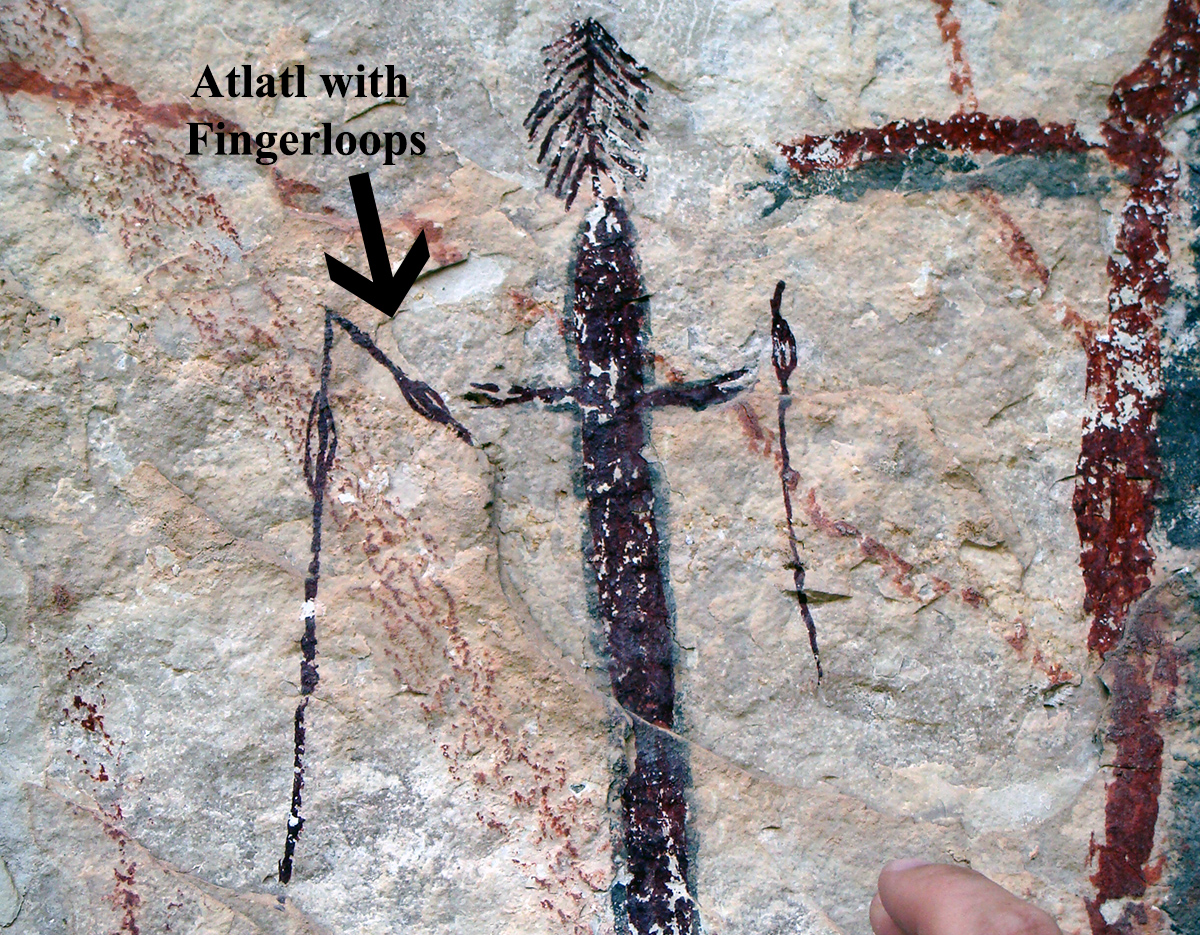
These are just a few examples of cave sites where atlatl use is depicted in cave paintings. These artistic representations provide valuable insights into the ancient hunting practices and the significance of the atlatl in early human societies.
The Atlatl in the New World
The New World showcases the use of atlatls in the art and archaeology of various pre-Columbian cultures. Atlatls are depicted in the artistic expressions of the Basketmaker culture in the American Southwest, the Maya in the Yucatán Peninsula, and the Moche in the Andes of South America.
Complete wooden spear throwers have been uncovered in different environments. Dry sites in the western United States have revealed well-preserved wooden atlatls, while waterlogged areas in Florida and Washington have also yielded these artifacts.
These discoveries offer valuable insights into the widespread utilization of atlatls across diverse regions of the New World. They underscore the tool’s significance in the hunting and cultural practices of ancient civilizations. The presence of atlatls in the art and artifacts serves as tangible evidence of their importance and integration into the daily lives of pre-Columbian communities.

An Old Word in the New World
It is in fact the aboriginals of the New World, specifically South America that we use the word “atlatl” to describe a spear thrower device.
The term “atlatl” is derived from the Nahuatl language, spoken by the Aztecs and other indigenous peoples of Mesoamerica. The Nahuatl word “atlatl” refers specifically to the spear-throwing device, known as the atlatl in English.
The Mesoamerican cultures, including the Aztecs, Mayans, and earlier civilizations such as the Olmecs, are credited with the development and widespread use of the atlatl. These cultures incorporated the atlatl into their hunting, warfare, and ceremonial practices.
The word “atlatl” has been adopted by modern English-speaking scholars and enthusiasts to refer to this ancient spear-throwing device. It serves as a standardized term used to describe similar spear-throwers found in different cultures around the world.

Atlatl in New World Art
Here are some examples of artworks from the New World where atlatls are represented:
- “Basketmaker Petroglyphs” – Petroglyphs found in the American Southwest. Specifically associated with the Basketmaker culture, depict hunters using atlatls in their hunting scenes.
- “Mayan Stelae” – In Maya civilization, stone stelae often portray rulers and warriors holding atlatls as symbols of power and military prowess.
- “Moche Ceramics” – The Moche culture of the Andes in South America. They created intricate ceramics that depict warriors engaged in battle, with atlatls prominently displayed as part of their weaponry.
- “Teotihuacan Murals” – The murals found in the ancient city of Teotihuacan in Central Mexico. They depict warriors equipped with atlatls, emphasizing their significance within the warrior culture of the time.

These artworks provide visual evidence of the widespread use and cultural importance of atlatls among different pre-Columbian societies in the New World. They offer valuable insights into the role of atlatls in hunting, warfare, and the symbolic representation of power within these ancient cultures.
Amentum
Although the atlatl seems to have slowly disappeared from Europe, the throwing of javelins continued.
The amentum, also known as the Greek term ἀγκύλη, was a device similar to an atlatl that was used in ancient times. It was primarily employed during the Classical period of ancient Greece, dating roughly from the 5th to the 4th century BCE.

It was used for hunting, competitive throwing, and in warfare. The amentum is much simpler to construct an atlatl as the amentum consists of a simple strap, typically of leather. It functions on the same principle as an atlatl, it increases the leverage applied to the projectile, increasing its speed. The technique involved in using the device also imparts a rotation to the javelin, much like the rifling of a gun barrel. This increases the stability of the projectile and hence its potential accuracy.
The device was, with one end, tied or looped around the center of mass of the javelin with the other end looping around the index and middle finger. The following video illustrates some basic javelin throwing with an amentum.
Swiss arrow
Another device similar to an atlatl and even more so to an amentum is the so-called “Swiss Arrow”. They are slightly larger than archery arrows, coming in on average, at 2.5 to 4 feet in length.
The device goes by many other names. These include the Yorkshire arrow, Dutch arrow, Scotch arrow, Gypsy arrow, or simply a throwing arrow.
The history of this particular device is obscure, but it seems to be rather ancient. The technology to manufacture and use it goes back into the distant past, much like the bow and arrow or the sling.
Below is a good video on how to make and use one of these for those that are interested.
Woomera
The atlatl from down under. The Australian woomera, also known as a spear-thrower, is an ancient Indigenous Australian tool that dates back thousands of years. It was invented by Indigenous peoples in Australia to enhance the throwing distance, velocity, and accuracy of spears. The woomera played a crucial role in hunting and warfare, as well as in cultural ceremonies and rituals.
The exact time of the woomera’s invention is uncertain, but it is believed to have been developed during the early stages of human settlement in Australia, around 40,000 to 60,000 years ago. This ingenious tool revolutionized hunting techniques, allowing Indigenous Australians to effectively target and capture their prey.
Appearance & Function
In terms of appearance, a woomera typically consists of a long, flat piece of wood, usually made from mulga or other hardwoods. It features a groove or hook at the end, where the spear shaft is inserted and secured. The woomera’s length can vary, with some reaching up to a meter long, depending on regional variations and personal preferences.
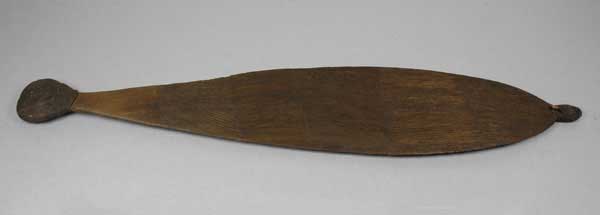
The primary function of the woomera is to extend the throwing arm’s length and provide leverage when propelling a spear. By using the woomera, the thrower can generate increased force and speed, resulting in longer throws and improved accuracy. The hook or groove at the end of the woomera securely holds the spear in place, allowing the thrower to effectively transfer energy from their arm to the spear during the throwing motion.
When using the woomera, the thrower holds the tool in their hand, gripping it near the middle or toward the back end. The spear is placed into the groove or hook, with the spear’s butt end resting against a projection or spur on the woomera. With a rapid and fluid motion, the thrower swings their arm forward. Releasing the spear at the precise moment to achieve maximum distance and accuracy.
The woomera enabled Indigenous Australians to effectively hunt a wide range of animals, including kangaroos, emus, and other small to medium-sized game. The added velocity and range provided by the woomera increased the chances of a successful hunt, improving the community’s food resources and overall survival.
Beyond its practical applications, the woomera held significant cultural and ceremonial value. It was often decorated with intricate carvings and designs, reflecting the cultural beliefs and identity of the Indigenous communities. The woomera’s presence in ceremonies and rituals symbolized the connection between the people, the land, and their ancestral spirits.
Atlatl Darts
Atlatl darts, pivotal projectiles used alongside the atlatl spear-thrower, were meticulously crafted by ancient civilizations. These darts were primarily fashioned from lightweight materials. This included wood, bone, or antler, allowing for swift and accurate throws. Typically atlatl darts measure 1.5 to 2.5 meters in length. These darts featured a sharpened tip, enabling effective penetration of the target.
Archaeological findings have provided invaluable insights into the production and utilization of atlatl darts across diverse cultures. In North America, the Clovis culture left behind distinctive fluted stone points. These were affixed to their atlatl darts, showcasing their exceptional craftsmanship and hunting expertise. Furthermore, the Solutrean culture of Europe showcased their mastery in atlatl technology by fashioning darts from reindeer antlers, highlighting the resourcefulness and adaptability of ancient societies.
The discovery of these archaeological examples not only underscores the widespread usage of atlatl darts but also illuminates the cultural significance attached to hunting and warfare. These artifacts serve as tangible links to our ancestral past. They offer a glimpse into the technological advancements and survival strategies employed by early human civilizations.
Atlatl Vs Spear
| Atlatl Darts | Spears |
|---|---|
| Pros | Pros |
| 1. Lightweight, enabling greater mobility | 1. Longer reach, useful in close combat |
| 2. Can be thrown with greater speed | 2. Sturdier construction, less prone to damage |
| 3. Enhanced accuracy at longer distances | 3. Versatility in hunting large game |
| 4. Easy to manufacture and replace | 4. Effective for thrusting and piercing |
| Cons | Cons |
| 1. Limited effective range | 1. Heavier, reducing mobility |
| 2. Requires skill and practice to master | 2. Less maneuverable in tight spaces |
| 3. Vulnerable to breakage or loss | 3. Less accuracy at longer distances |
| 4. Less suitable for close combat situations | 4. May require more effort to wield |
How to Use an Atlatl
The proficient use of an atlatl does take some practice. Yet with some dedication, it is relatively easily learned for most who attempt. There are plenty of very good demonstrations and videos on the internet that will give the reader a good idea of how to get a powerful and accurate throw.

Atlatl Hunting
As you may have already read by now, the atlatl was a very useful device for hunting. It increased the range and power of a spear-like projectile and this has many advantages.
First of all, with increased range, the thrower does not have to get so close to an animal. In the early days, with large and dangerous animals lurking around, this is definitely a huge advantage.
Secondly, the atlatl delivers more energy to the projectile, thus increasing the likelihood of a kill. This is humane to the animal and helps keep the hunter safe as well.
Be assured, there are modern hunters using this ancient hunting device and technique to this very day. It is definitely not as easy as hunting with a rifle!
How to Make an Atlatl
The atlatl is a relatively simple device that is easy to make. Our ancestors tens of thousands of years ago became quite good and manufacturing these devices.
They were typically made out of a hard substance such as hard wood, antler, stone etc.
Check out the video below for some more inspiration and instruction.
Are Atlatls Illegal?
An atlatl itself is a simple instrument, many are made of carved wood. An atlatl by itself is no more dangerous than a tennis racquet. Coupled with a projectile however and you may have a problem. If you want to take one hunting and try it out, you will have to take the responsibility of familiarizing yourself with the laws of the land. This will vary from state to state, province to province, and country to country.
We are not here to give legal advice. Some general advice you can’t go wrong with would be: investigate the laws of the land for yourself and ensure you don’t get into any unwanted trouble.
Here is a story about the banning of spears and atlatls in Alberta, Canada.
https://www.cbc.ca/news/canada/edmonton/spear-hunting-big-game-alberta-1.4524371
Modern Atlatl
As you can see from the many videos of atlatl construction and usage in modern times that the device is still around and doing well. In fact, there seems to have been a resurgence in interest which may be correlated to an overall rise in interest in bushcraft and survivalism in general.
There is in fact a whole community of enthusiasts that love to build and use their atlatls in a competitive environment.
Check out the World Atlatl Associations website here: https://worldatlatl.org/
There is also a great list of literature for your further reading here: https://worldatlatl.org/about-atlatls/atlatl-literature/
There are some modern, mass manufactured atlatls available on the market as well. They use modern materials and put a new spin on an age old classic.
Thank you, take care and God bless!
REFERENCES
[1] Snir, Ainit (2015). “The Origin of Cultivation and Proto-Weeds, Long before Neolithic Farming”. PLOS ONE. 10 (7): e0131422. Bibcode:2015PLoSO..1031422S. doi:10.1371/journal.pone.0131422. PMC 4511808. PMID 26200895.
[2] Allington-Jones, L., (2015) Archaeological Journal, 172 (2) 273–296 The Clacton Spear – The Last One Hundred Years
[3] Schoch, W.; et al. (2015-12-01). “New insights on the wooden weapons from the Paleolithic site of Schöningen”. Journal of Human Evolution. 89: 214–225. doi:10.1016/j.jhevol.2015.08.004. ISSN 0047-2484. PMID 26442632.
[4] McClellan, James Edward; Dorn, Harold (2006). Science and technology in world history: an introduction. Johns Hopkins University Press. p. 11. ISBN 978-0-8018-8360-6.
[5] Peregrine, Peter N.; Ember, Melvin (2001). “Europe”. Encyclopedia of Prehistory. Vol. 4. Springer. ISBN 978-0-306-46258-0.
[6] “Mungo Lady and Mungo Man”. mungo. n.d. Retrieved November 3, 2018.

